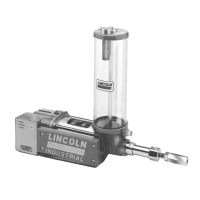
Do you have a question about the Lincoln CENTRO-MATIC B Series and is the answer not in the manual?
| Power Source | Electric |
|---|---|
| Weight | Varies by model |
| Series | B Series |
| Application | Industrial |
| Flow Rate | Varies by model |
| Pressure | Varies by model |
| Motor Power | Varies by model |
| Voltage | Varies by model |
| Material | Cast Iron |
| Inlet Size | Varies by model |
| Outlet Size | Varies by model |
| Model | B Series |
| Phase | Single or Three Phase (Varies by model) |
Warning about potential electrical hazard and serious injury if instructions are not followed.
Explains the single-stroke positive displacement pumps and their primary use in lubrication systems.
Defines the intended use for centralized lubrication systems and warns against other applications.
Describes system operation when the dipswitch is set to 'Memory Off' for lube cycle initiation.
Details system behavior when the dipswitch is set to 'Memory On' during power interruptions.
Identifies the function of dipswitches for configuring timer and controller settings.
Explains the rotary switch used for setting off-time intervals between lube cycles.
Describes the function of the Green LED, Red LED, and Manual Lube button on the enclosure cover.
Explains pump operation in Timer mode, including low-level switch interaction.
Details pump operation in Controller mode with pressure monitoring capabilities.
Instructions for filling oil reservoirs through the filler cap.
Details how to supply lubricant to specific models from remote sources.
Instructions for filling grease reservoirs using a manual filler pump.
Explains how to prime lines with lubricant for proper pump and system operation.
Offers advice on keeping the lubrication system clean and preventing contamination.
Guides users on diagnosing problems by dividing them into electrical, pneumatic, and hydraulic areas.
Step-by-step instructions for replacing the timer/controller module.
Details procedures for draining and servicing oil reservoirs.
Outlines steps for disassembling, servicing, and reassembling grease reservoirs.
Covers non-operation, seized condition, inconsistent cycling, and system failure to cycle.
Addresses injector pin return failure and partial injector delivery.
Discusses causes and actions for over/under-lubricated bearing points.
Troubleshoots the 'Lube Alarm' LED that prevents the next automatic lube cycle without alarm monitoring.
Addresses partial injector delivery without an active alarm condition being triggered.
Troubleshoots the 'Lube Alarm' LED that prevents the next automatic lube cycle in monitored systems.